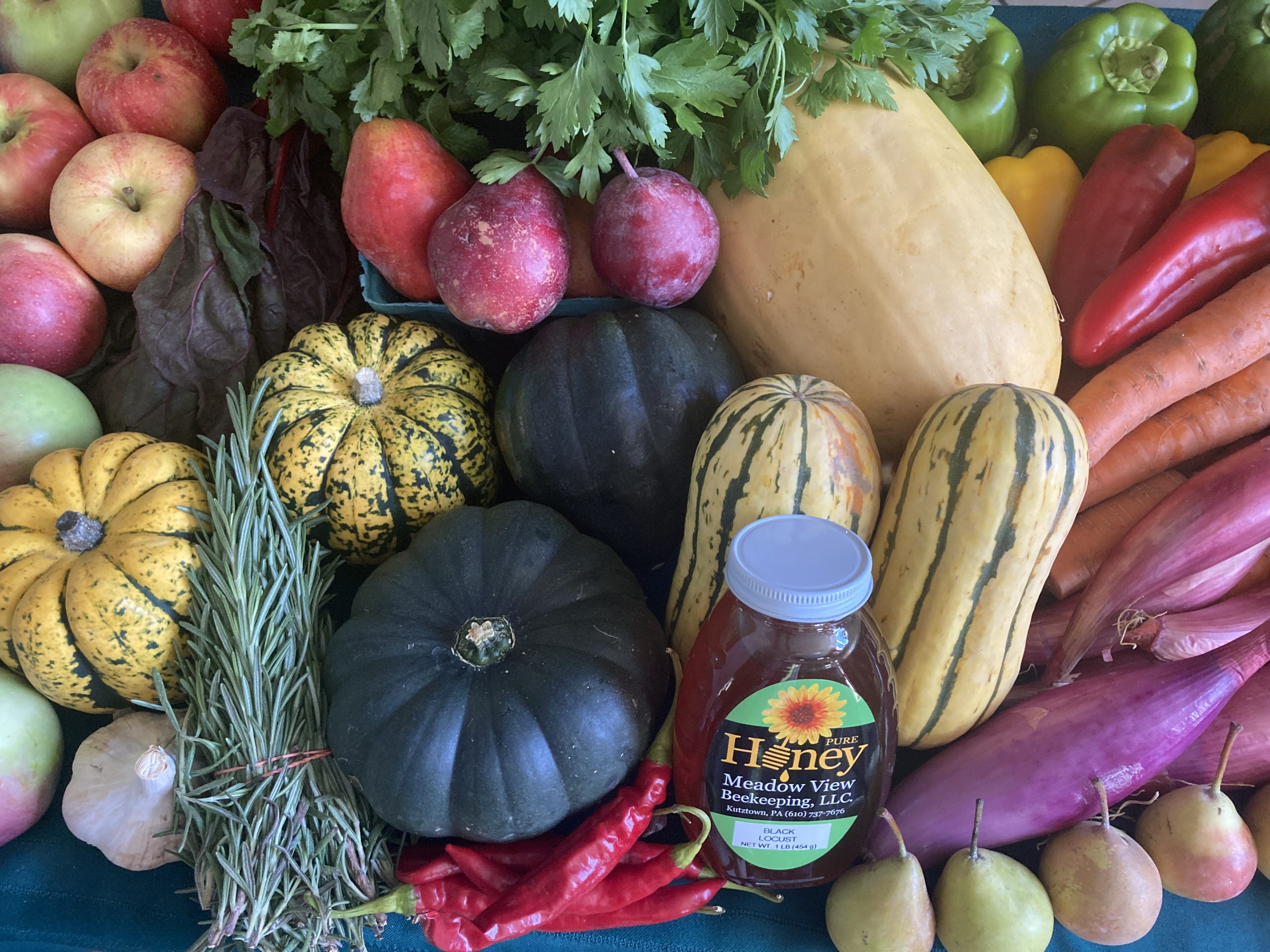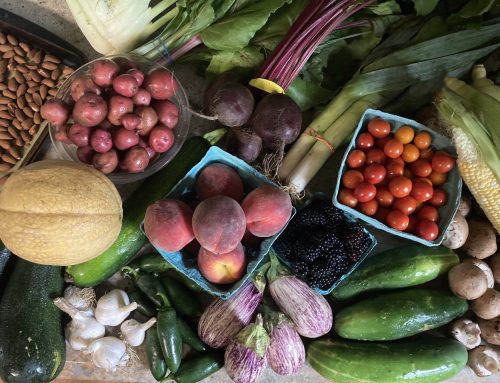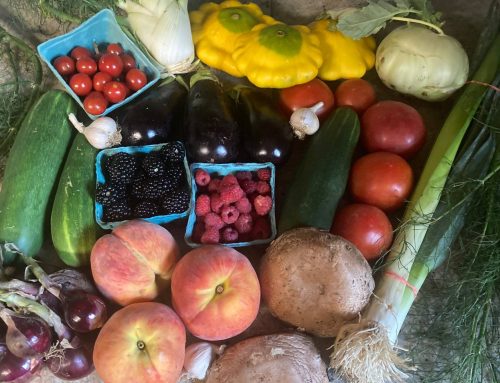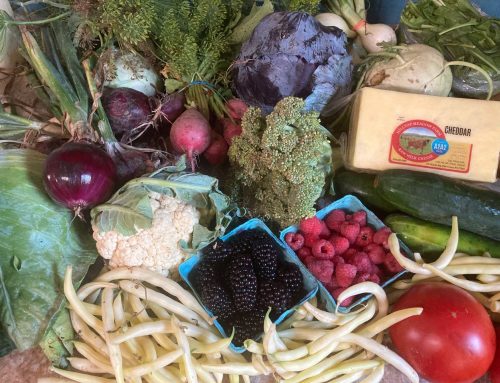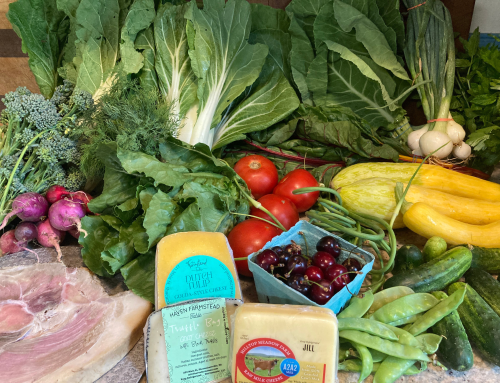Veggies We Harvested This Week: Sept. 19, 2023
Every member’s customized Market Box is unique so we hope you will take advantage more varieties of vegetables as you get comfortable with all the great organic produce we are offering. Use our A to Z Vegetable Guide to help use and store your veggies. Storage tips and RECIPES below.
Storage & Usage Tips
If you wan to know how the Black Locust Honey tastes or how to use the different varieties of Winter Squash, this video is for you. Even experienced farm members learn something new here.
Coming Soon: Sweet Potatoes If you want those the first time they are offered, make sure they are rated 5 in your preferences and there aren’t too many other competing 5s.
What to use first: eggplant, tomatoes, microgreens,
Finished for the season: Asparagus, basil, garlic scapes, snap peas, cucumber, chamomile, rhubarb, scallions, tomatillos
Done for now but will return: Broccoli, Bok choy, Radish, Cabbage, Napa Cabbage, Collards, Kale, Kohlrabi, Greens Beans
Green & Yellow Beans – Beans should be stored in a loosely sealed plastic bag for about a week in the crisper drawer. The yellow beans taste the same as the green and are not “wax” beans. Yellow beans do retain their flavor when cooked. Green Bean & Cranberry Salad, Green Bean Salad with Red Onion & Tomato or See this post for Freezing Fresh Beans.
Beets, red – If greens are attached to the beets, cut the stems two inches about the beet root bulb. Store greens separately. Use beet greens first, within one or two days. One way to use my Feta cheese would be in this dish: NEW RECIPE: Chocolate Beet Cake
Cilantro – Cilantro, also known as coriander leaves or Chinese parsley, is a vibrant green herb with delicate, lacy leaves and a fresh, citrusy, and slightly peppery flavor, often used to add a burst of distinctive, herbaceous zest to Mexican, Thai and curry dishes. Usage: add to salads, stir fries, and curries. Cilantro pairs well with summer squash, eggplant, tomatoes, cucumbers, and onion. Storage: Cilantro, like all herbs, will not last long once picked. Place upright in a glass of water in the fridge or on your kitchen counter. If you cannot use the Cilantro this week, preserve the herb by purreeing and popping into ice cube trays or make chimichurri sauce.
Eggplant can be left unrefrigerated at a cool room temperature for a day or two or in the crisper drawer for one week but it tastes best when used soon after picking. Eggplant can be peeled or unpeeled depending on the type of dish you are preparing.Just like a zucchini doesn’t have much flavor on its own so it’s often paired with other veggies in a dish, so, too, the eggplant is often paired with other stronger flavors. It can be sauteed, baked, fried, grilled, or steamed. Have you checked out my blog post for FIVE EASY STRATEGIES FOR PREVENTING EGGPLANT OVERLOAD? NEW RECIPE: Sauteéd Eggplant is a simple lunch dish we make often, or as a side for dinner. Eggplant is amazing with a dollop of yogurt!
Salting & Draining Eggplant – It’s a good idea, if time allows, to salt the sliced or chopped eggplant and soak in water for about 15 minutes and then gently drain and squeeze to get rid of acrid flavors according to From Asparagus to Zucchini cookbook.
Eggplant, Japanese – slender varieties of many color variations of purple and white, see pictures above. Lends well to sliced circles.
Eggplant, Purple – Italian globe variety lends itself to stuffing, slicing, cubing and roasting. You can freeze eggplant when it is cooked in a dish like ratatouille or baba ghanouj, and enjoy the classic eggplant parmesan or pick from these 8 simple ways to cook eggplant.
Garlic – should be kept in a cool, dry place. All our garlic is now cured so it can be stored in a cool, dark, dry place for several months. RECIPE: Roasted Garlic Potato Soup
Lettuce, Romaine – Store your lettuce properly and enjoy summer salads with sliced vegetables from your box.
Kale – Curly Kale. Store in a loosely sealed plastic bag in the crisper drawer for 7-10 days. To freeze, wash and chop into small pieces and place in a freezer bag. This would be delicious used in the winter in a potato soup or vegetable stir fry. I love it sauteed with garlic and olive oil until bright green and tender. Add Kielbasa to your cart and try this Kale and Kielbasa Soup. Have you tried Kale Chips yet?
Microgreens – Refrigerate immediately. Keep bag sealed. Fold down to remove most air. Put in coldest part of refrigerator. Often, a bottom shelf. Can be frozen to add later to soups and other meals. Check out Emanuel Farm Powdered Microgreens for longer term shelf life. They are a tasty, nutrient-rich boost for shakes, smoothies and meals and a great seasoning for adding flavor to dishes and dips. All our micro greens are from Emanuel Farms.
Onion, red – I’ve been looking forward to these fresh, colorful onions. Use them in raw salads and salsas. They not for long term storage, so keep them in the fridge for up to a few weeks. Download the Onion Guide – see below. Here is a Corn Salad recipe that uses your red onion too. NEW RECIPE: Vegan Lentil Soup Green Beans and Caramelized Onions
Parsley – Store as you would any herb; in a glass with some water on the counter. Keeps for several days. Use in Tabouleh Salad, salad dressings, potatoes and Green Sauce to use up your herbs.
Peppers – are a popular and versatile vegetable that comes in various colors, including green, red, yellow, orange, and even purple. They belong to the nightshade family and have a mildly sweet flavor with a crisp texture. Peppers are low in calories and fat but rich in vitamins and minerals. They are particularly high in vitamin C, providing more than 100% of the recommended daily intake per serving. Peppers also contain vitamin A, vitamin B6, dietary fiber, and antioxidants, such as carotenoids and flavonoids, which contribute to their vibrant colors and potential health benefits.
Storage for all peppers: keep them dry and refrigerated in a perforated plastic bag for up to one to two weeks. Avoid storing them with fruits or vegetables that emit ethylene gas, as this can cause them to spoil faster.
Usage: Peppers can be used raw in salads or as a crunchy snack, and they are excellent for stir-fries, sautés, soups, stuffed dishes, or grilled kebabs, adding flavor and nutrition to various meals. Their different colors can also add an appealing visual touch to your dishes.
Green Bell Peppers– Green peppers pack the most nutritious punch when eaten raw. Try on salads, sandwiches, or dipped into a favorite dip. Cooked, green pepper can be used in soups, chili, casseroles, egg dishes, or stir-fries. Can be sliced, diced and frozen for later cooked dishes. Pepper & Chicken Stir Fry Recipe or Fresh Garden Soup
Colored Sweet Peppers – Sweet peppers are the fully ripened green pepper and have high levels of vitamins A, C, and E as well as iron and potassium. They are delicious eaten raw, adding color and flavor to all sorts of salads, salsas and cooked dishes. Place these sweet colored peppers in the fridge for up to a week. Can be sliced, diced and frozen for later cooked dishes. Baked Penne with Summer Vegetables, Lasagna Stuffed Peppers
Hungarian Wax – also known as hot wax peppers or hot banana peppers, are elongated chili peppers originating from Hungary. They have a mildly spicy flavor, ranging from mild to moderately hot, and are commonly used in cooking and pickling due to their versatility and unique taste. Nutritionally, Hungarian wax peppers have the added health benefits from the compound capsaicin.
Usage: Hungarian wax peppers can be used raw in salads, sandwiches, or as a zesty garnish for tacos and burgers. For cooking, try sautéing, grilling, roasting, or stuffing them with fillings like cheese, rice, or seasoned meats. Incorporate these peppers into sauces, soups, stews, or stir-fries for added depth and heat to your dishes.Consider pickling any excess peppers for prolonged enjoyment of their tangy flavor.
Heat Index: The heat level of Hungarian wax peppers can vary from mild to moderately hot, depending on their ripeness and individual variation. Pale yellow peppers tend to be milder, while fully ripe red peppers may have more significant heat. Taste a small piece before use to gauge spiciness and adjust according to your preference.
Jalapeño – a popular variety of chili peppers with a distinctive bright green or red color when fully ripe. They are low in calories and fat while providing a good amount of vitamins A and C, as well as potassium and dietary fiber. They also contain capsaicin, the compound responsible for their spiciness, which is known for its potential health benefits, such as pain relief and metabolism-boosting properties.
Usage: Jalapeño peppers are commonly used raw in salsas, guacamole, and as a topping for tacos, nachos, pizza and other dishes. When cooked, jalapeños add a bold kick to soups, stews, sauces, and stir-fries. They can also be roasted, stuffed, or incorporated into marinades for meats and vegetables, offering a depth of flavor and heat.
Heat Index: Jalapeño peppers are known for their moderate to high heat level, typically ranging from 2,500 to 8,000 Scoville Heat Units (SHU). The level of spiciness can vary depending on factors such as ripeness and the specific pepper’s genetics. IMPORTANT: USE GLOVES! Be cautious when handling jalapeños (at least if you are handling more than a few at a time or are sensitive), as their seeds and membranes contain the most capsaicin and can intensify the heat. Remove these parts if you prefer a milder flavor or keep them for a spicier kick.
Serrano – are hot chili peppers widely used in Mexican and Latin American cuisines. They are smaller and narrower than jalapeño peppers, with a bright green or red color when fully ripe.
Usage: Serrano peppers are a staple in many spicy dishes. They can be used raw in salsas, guacamole, or as a garnish for tacos, enchiladas, and other Mexican dishes, adding a bold kick to the flavors. When cooked, serrano peppers infuse stews, sauces, soups, and stir-fries with their fiery heat and rich flavor. They can be roasted, grilled, or charred to enhance their taste and used in marinades for meats and vegetables.
Heat Index: Serrano peppers have a Scoville Heat Unit (SHU) ranging from 10,000 to 23,000, making them hotter than jalapeños but milder than some other chili peppers like habaneros or ghost peppers. USE CAUTION! USE GLOVES! Many an american cook has thought, “these don’t bother my skin”, until they can’t sleep at night because of the burning sensation.
Potato, White – a this type of potato is called “Superior” and boasts a smooth, light tan skin and creamy white flesh, with a medium-sized, slightly oval shape that makes it versatile for cooking. These potatoes are a source of carbohydrates, dietary fiber, vitamin C, vitamin B6, and potassium, offering essential nutrients for a balanced diet.
Storage: Store white potatoes in a cool, dark, and well-ventilated place to prevent sprouting and spoilage. Avoid exposure to light, which can cause the potatoes to turn green and develop a bitter taste. Keeping them in a paper bag or a breathable container helps maintain their quality.
Usage: The versatility of white potatoes makes them suitable for various cooking methods. Boil them for salads or side dishes as they hold their shape well. Their creamy texture shines when mashed, creating velvety purees. These potatoes are also excellent for baking, roasting, and frying, absorbing flavors to perfection. Their neutral taste pairs well with a wide range of seasonings and ingredients, making them adaptable to countless recipes.. RECIPES: These are the perfect potatoes for fries, potato chips and classic baked potatoes. Try Cheesy Mashed Potato Waffles, or Tortilla de Papas
Sweet Corn – To prepare sweet corn, peel off husks and silk. Boil in water for 5 – 8 minutes and serve hot with plenty of good butter and salt. You can eat corn raw or cook it in the oven or grill with the husks on (usually after soaking them in water.) . Shuck the cob by pulling the husks down the ear and snapping off the stem. The silks will fall off as you cook the corn. Rinse under cold water. If you see a worm in the tip, just cut out the damaged section — the rest of the cob is still edible! To cut the kernels off the cob, stand the cob upright on its base and run a sharp knife from the tip of the ear down to the base. Save those used cobs for making broth!You can store sweet corn in the fridge for a day or two but you should eat it soon for the best flavor. Need recipes? 30 Sweet Corn Recipes. Here is a Corn Salad recipe that uses your red onion too.
Swiss Chard – a leafy green vegetable, features vibrant, colorful stems in shades of red, pink, orange, yellow, or white, and large, glossy, dark green leaves. It belongs to the beet family and is rich in vitamins and minerals. Swiss chard is a nutritional powerhouse, providing vitamins A, K, and C, as well as minerals like magnesium, potassium, and iron. It is also low in calories and carbohydrates, making it an excellent addition to a balanced diet. Storage: To store Swiss chard, first remove any bands or ties around the leaves to prevent moisture buildup. Wrap the leaves in a damp paper towel and place them in a plastic bag, then store them in the refrigerator’s vegetable drawer. The stems can be stored in a separate bag. Proper storage can help extend the freshness of Swiss chard for up to a week. Usage: Both the leaves and stems of Swiss chard are edible and can be used in various culinary creations. The leaves have a slightly earthy and slightly bitter taste, similar to spinach or kale, while the stems have a milder flavor and a satisfying crunch. Swiss chard can be enjoyed sautéed, steamed, or boiled as a side dish. The leaves can also be used as a wrap for fillings. The stems can be cooked and used in stir-fries or soups, contributing color and texture to the dishes. This is a perfect week for New Recipe: Corn & Swiss Chard Bruschetta and here is the recipe I mentioned in the video, although we use grass fed butter instead of olive oil. Be generous with the cheese and cook until very tender: Baked Chard Stems
Tomato, Red – Keep tomatoes stem side down on the counter at room temperature. Tomatoes should not be refrigerated. Use within a week. Tomatoes are high ethylene producers, which means they will cause other produce to ripen quickly (or spoil quickly) if placed nearby. So be careful what you store next to tomatoes. Use a very sharp, serrated knife to cut them. Try Fresh Tomato Soup, with variations. These Simple and Reliable Tomato Recipes include Fresh Pasta Sauce, Gazpacho, Caprese Salad.
Tomato, Medium – This size of tomato is about the size of a golf ball. Use like a large cherry tomato.
Tomato, Cherry – Store on the counter; do not refrigerate. Snack or use in salad, frittata or pizza. RECIPE: Green Bean and Cherry Tomato Salad or Grilled Eggplant, Grape Tomato, and Feta Salad
Farm Food Highlights
FRUIT:
Apples: for all apples Storage: Extend the shelf life of apples by refrigerating them in the crisper drawer for a few weeks. Keep them separate from other produce to prevent accelerated ripening due to ethylene gas release.
Apples, Cortland – One of the most distinctive features of Cortland apples is their pure white flesh. Unlike many other apple varieties, Cortlands do not oxidize (turn brown) quickly when sliced, making them an excellent choice for salads and fresh presentations. Like Honeycrisp and Jonamac, are sweet, crisp eating apples cherished for their wonderful flavor. Usage: Cortland apples are versatile and enjoyable fresh, offering a sweet-tart taste and crisp texture. Slice them into salads for a refreshing crunch. In cooking and baking, Cortlands maintain their firmness, making them great for pies, tarts, and sauces. They contribute a harmonious sweetness to both sweet and savory recipes.
Apples, Gala – A sweet, crisp eating apple offering a delightful combination of sweetness and subtle tartness, making them a universally enjoyable apple variety. Usage: These versatile apples can be enjoyed fresh, sliced into salads for added crunch, or used in cooking and baking. Their firm texture holds up well in pies, tarts, and sauces, contributing a balanced sweetness to both sweet and savory dishes.
Tessa: I enjoyed my Gala apple sliced and dipped in Almond butter. I also love to add a light sprinkly of gray sea salt to my apples to intensify the sweetness!
Apples, Honeycrisp – A sweet, crisp eating apple with a wonderful flavor. Honeycrisp apples are renowned for their outstanding sweet, crisp, and juicy flavor. They are often considered one of the tastiest apple varieties available. Usage: Honeycrisp apples are incredibly versatile. Enjoy them fresh for a sweet, juicy snack or slice them into salads to add a satisfying crunch. They are also excellent for cooking and baking, holding their firm texture well in pies, tarts, and sauces. Their balanced sweetness enhances both sweet and savory dishes. Extra long Storage: Compared to many other apple varieties, Honeycrisps have a relatively long shelf life when properly stored, allowing them to remain fresh and delicious for an extended period.
Apples, Jonamac – Jonamac apples have a unique heritage, being a cross between the Jonathan and McIntosh varieties. This lineage contributes to their distinctive flavor profile. Similar to Honeycrisp, Jonamac apples offer a sweet, crisp eating experience with a delightful flavor. Usage: Jonamac apples are perfect for fresh consumption, providing a sweet-tart crunch. Slice them into salads for added texture. When it comes to cooking and baking, Jonamacs hold their shape admirably in pies, tarts, and sauces, infusing a balanced sweetness into various dishes.
Apples, MacIntosh – Very aromatic, filling the rooms with apple scent. Due to their tender flesh, McIntosh apples are often used for making applesauce. When cooked, they break down easily, resulting in a smooth and flavorful applesauce. Usage: These versatile apples can be enjoyed fresh, sliced into salads for added crunch, or used in cooking and baking. Due to their tender flesh, McIntosh apples are often used for making applesauce. When cooked, they break down easily, resulting in a smooth and flavorful applesauce.
How to Store Common Pears:
Room Temperature: Store unripe pears at room temperature, preferably in a fruit bowl or paper bag. This allows them to ripen slowly and develop flavor. Check them daily for ripeness.
Refrigeration: Once ripe, move pears to the refrigerator to extend their shelf life. Keep them in the crisper drawer, preferably in a perforated plastic bag to maintain humidity and prevent them from absorbing strong odors.
Use Quickly: Once pears reach the desired ripeness, consume them promptly for the best flavor and texture. Ripe pears can be kept at room temperature for a day or two if needed.
TIP: Keep pears away from strong-smelling foods like onions and garlic as they can absorb odors.
Check: your pears regularly, especially when stored in the refrigerator, to remove any overripe or spoiled ones to prevent them from affecting the others.
Bosc pears are known for their distinctive appearance with a rough, russeted skin, and their firm, dense texture. They have a rich and complex flavor, combining sweetness with a subtle spiciness. These pears are versatile in cooking, as they hold their shape well when baked, poached, or grilled. They are also ideal for slicing into salads and pairing with cheeses due to their firm texture and robust flavor.
Bartlett pears are renowned for their exceptionally juicy and sweet flesh, which is slightly grainy in texture when fully ripe. They are one of the few pear varieties that change color as they ripen, transitioning from green to a vibrant yellow when ripe. Usage: perfect for fresh eating and snacking when fully ripe, offering a juicy and sweet flavor. Additionally, they excel in canning, baking (in pies, tarts, and crisps), and can be transformed into smooth purees and sweet sauces for a wide range of recipes.
Forelle pears are known for their sweet and tart flavor, offering a delightful balance of sugary sweetness and subtle tartness. They are versatile in usage, often enjoyed as a crisp and refreshing snack due to their small size, and their striking appearance makes them an attractive addition to salads, fruit platters, and desserts. Their edible skin and crisp texture contribute to their versatility in both fresh eating and culinary applications, making them a unique and appealing choice for various dishes.
Our members are cooking…
Farm members are sharing recipes and photos of their delicious meals on our Member Only Chat Group. Use the link in the email you received from me today.
Veggie E-Books
Download these collections of tips and recipes for each veggie. You’ll use these as a reference throughout the season.
Herb E-book (Parsley & Cilantro recipes)
Kale E-book
Onion E-Book
Green Beans E-Book
Potato E-book
Sweet Corn E-book
6 Types of Onions and How to Use Them
Don’t Miss Your Farm Events:
Open Gate Farm Tour
Saturday & Sunday, Oct 14 & 15. 1 pm – 5 pm.
Market Box Value!
Five of our Top Tips to get the most value out of your Market Box and enjoy the most food you’ll love. Read Here.
Your List of What to Return:
Please return the packaging we sent you for your last delivery. Here’s how and what exactly we’ll take back: Read Here.
We’ll Keep Farming for You!

